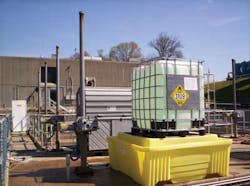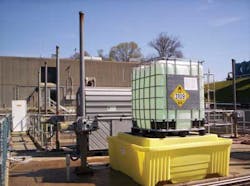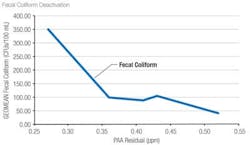By John Maziuk, Robert T. Freeborn, and Chuck Murphy
The secondary treatment system of a wastewater treatment plant in the city of Steubenville, Ohio, needed to find a cost-effective wastewater disinfection method that did not generate chlorinated byproducts. The procedure included testing various dosages and holding times in the secondary lagoon, and payoff and performance data was collected during the study.
The secondary system had a total plant capacity of 13.5 MGD. Solvay Chemicals Inc., together with PERAGreen Solutions, conducted independent plant scale trials using Proxitane® WW-12 peracetic acid (PAA). In addition to PAA feed and control, daily fecal tests were conducted to verify product efficacy as well as "WET" testing on the final secondary discharge.
The plant was operating between 5 and 8 MGD. PAA dosage never exceeded 1.5 ppm, and the residual averaged 0.4 ppm (but did not exceed 1 ppm). PAA feed was flow paced, CBOD remained constant and pathogen control was always within the permit limits.
Initially, a proposal was prepared in March 2011 to evaluate PAA on both "Capture" and "Event" during wet weather conditions, with a complete report issued based on accumulated data and subsequent flow studies to correct hydraulic anomalies at the levees. The pilot demonstration was extremely successful, with expected PAA consumption and pathogen destruction from the injection point, through the contact chamber and ultimately to the river discharge.
Fecal coliform levels of <10 CFUs/100 mL were achieved at the final outfall at a feed rate of 1.5 ppm of active PAA. Dosages were lowered throughout the demonstration to determine the lowest feed rate and PAA residual necessary to meet both summer and winter fecal coliform permit levels.
The study continued through April 2012 and then reverted to chlorine (15 percent liquid bleach) and dechlorination (sodium bisulfite) to provide head-to-head treatment evaluations for both technologies.
Both chlorine bleach and sodium hypochlorite could attain the same pathogen destruction but at dosage levels far in excess of PAA, making PAA very cost-competitive. The Ohio EPA was asked to extend the approved use of PAA through June 2012 to further evaluate improved feed and control in order to fine tune product dosage requirements.
PAA feed rates could be set at 0.6-0.7 ppm with PAA residuals at levels down to 0.32 ppm in the final discharge to meet all NPDES permit pathogen requirements. Further tests conducted in June 2012 were designed to improve PAA feed using modified pump controls to narrow the residual needed for maximum pathogen kill.
In summary, tests proved PAA to be not only effective in meeting all the NPDES permit requirements, but also extremely cost-effective based on head-to-head comparisons of PAA versus chlorine bleach and dechlorination.
The EPA recently published its updated Fact Sheet on PAA, identifying it as an effective wastewater disinfection treatment, and offering a complete overview of its applications, byproducts and shipping data, as well as documented case studies and results. To access the Fact Sheet, visit www.epa.gov.
About the Authors: John Maziuk is Technical Development Manager for Solvay Chemicals, Inc. Robert T. Freeborn is Vice President–Sales and Marketing for PERAGreen Solutions; Chuck Murphy is Assistant Superintendent for the City of Steubenville Wastewater Department.





